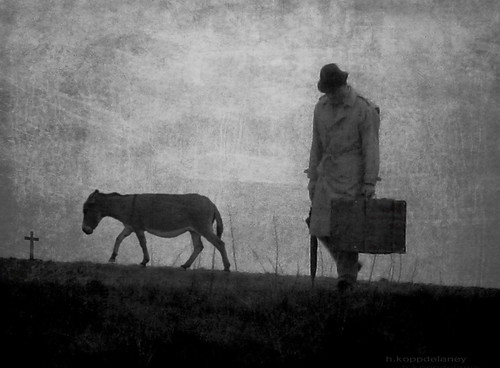Điều kiện cần yếu để phát minh sáng tạo, theo A. Einstein, là tâm tư ngoại lệ, không chấp trước, không thành kiến, tự do tưởng tượng, vô bờ, fantaisies, chứ không phải kiến thức đầy đặc thành khuôn nếp trong đầu, ông từng nói
Vật lý phá chấp
Điều kiện cần yếu để phát minh sáng tạo, theo A. Einstein, là tâm tư ngoại lệ, không chấp trước, không thành kiến, tự do tưởng tượng, vô bờ, fantaisies, chứ không phải kiến thức đầy đặc thành khuôn nếp trong đầu, ông từng nói : " I am enough of an artist to draw freely upon my imagination...the gift of fantasy has meant more to me than my talent for absorbing positive knowledge ", không tự do thì không có sáng tạo, không phá chấp, thì không thể chuyển hóa, cho nên giống như Phật pháp, cần phá chấp, không biên kiến, không bị kẹt vào có với không, nhỏ với to, cao hay thấp, tất cả chỉ là những danh từ, những kiến chấp, rất tương đối.
Không có biên giới giữa các sinh vật, con khỉ Ngộ được Không, cũng thành Tôn sư đại thánh, cho đến ma nữ yêu tinh...cũng chẳng sai biệt, quốc độ của họ còn nặng nghiệp, nhưng chẳng khác nhau bao nhiêu, cho nên nếu tu tập tinh tấn, chưa tới mức thiên nhãn, thiên nhĩ như Bồ tát, thiện nhân vẫn có thể "chiếu yêu kính" nhìn ra chân tướng, nghe được tiếng tạp giới chúng sinh...Cho nên tác giả Liêu Trai Chí Dị xóa hết bức tường chia cách: dạ xoa, chồn, cáo...vẫn có thể biến hóa, lấy người, yêu người, trong một khoảnh khắc kiếp hồng nhan...bông hoa, cánh bướm, thậm chí sâu bọ, cũng mang Phật tính, vũ trụ phá chấp, chúng sinh đồng nhất thể, người trần mắt thịt, làm sao biết cỏ cây sỏi đá vô giác vô tri ?
A. Einstein đã đi vào lộ trình phá chấp của Phật pháp, vạn pháp duy tâm tạo, tất cả Tứ đại-đất, nước, khí, lửa- vạn pháp giai không cũng được, mà vạn pháp giai hữu cũng được, " có thì có tự mảy may, không thì cả thế gian này cũng không" người bình dân VN ai cũng thuộc lòng thấm thía câu đó, hẳn nhà bác học Do Thái kia cũng đốn ngộ bừng thấy lý phổ quát tương đối trong vũ trụ, chẳng có lực nào riêng rẽ, cho nên, vật chất mới hóa thành năng lượng, được vận tốc ánh sáng bốc lên : E= MC 2, vũ trụ tam thiên đại thiên thế giới này, ống kính Hubbles thiên văn thấy là đa vũ trụ, toàn pháp giới Vô Lượng Quang tử, ánh sáng big bang, ánh sáng cong, ánh sáng xoáy vòng vào thiên ngục black hole...Nam mô A di đà...Amitabha, chỉ là cái tên cho nhân gian hiểu, thật ra, trên bình diện vũ trụ, nghĩa là quang tử, là photon, là quantum...gì gì nữa, vô lượng, vô khả luận...
Đã là vô lượng quang Amitabha, thì làm gì có không gian giam hãm, làm gì có thời gian non hay già...không đến, không đi, không còn, không mất, không nhơ, không sạch...cho nên cả vũ trụ có thể chứa trong một lỗ chân lông Bồ tát, tất cả ba thế giới trên đầu một hột cải...cái to trong cái nhỏ, cái nhỏ trong cái to, lớp lớp như những mảnh kính mảnh gương soi chiếu muôn chiều vô lượng...ánh sáng trong tâm cũng là ánh sáng trong vũ trụ và ánh sáng quanh mặt trời cũng chỉ thu vào đồng tử một con mèo...vi quang tử, photon, boson, vi tử Hoa nghiêm, nở trùng trùng hun hút vào chốn thiên thai, không gian mấy chiều cũng được và thời gian muôn ngả cũng vẫn đứng yên vì chiếc thảm thần tiên bay cùng vận tốc với cả giải ngân hà trăng sao... tại sao loài người thắc mắc về durée của đời sống, khi cõi tâm có tốc độ nhanh bằng hay hơn điện từ trường? nhảy một bước, như Tôn Ngộ Không, nhảy hai bước, từ thức, nhập cõi thiên thai...
Nhà vật lý học như A. Einstein thì không chịu chuyện " bất khả tư nghị", ông muốn biết Tạo Hóa nghĩ gì - I want to know God' thoughts; the rest are details- ông đi tìm Vũ trụ Thống nhất trường- Unified Theory, quân bằng phương trình, bó 4 lực lại thành một bó: trọng lực, điện từ lực, lực mạnh và lực yếu hạt nhân (gravitational-, electromagnetic- strong- weak- nuclear forces), nghĩa là không còn cách biệt giữa Không Thời gian,...Năm ngàn năm trước, Phục Hy cũng đã thống nhất hai lực Âm Dương, một âm một dương, tứ tượng, bát quái, rồi 64 quẻ... thống nhất quy vào Thái cực, nhưng trên Thái cực là gì ? là Tạo hóa chăng? là ông Trời chăng ?...hệ thống suy tưởng Âm Dương đã là cao, nhưng tới Thái cực thì vẫn chưa hết gợn sóng ý niệm, còn " Cực" dù là cực thái! Nhà Phật, thấy cái ngõ cụt ấy, phá hết biên kiến Vật- Tâm, quét sạch vọng niệm, tới mức phi tưởng, phi phi tưởng, tới mức Thiền bậc bảy bậc tám bậc chín...quán, tuệ.
Cuối đời, sau gần 30 năm mài miệt suy tưởng về Vũ trụ Thống nhất trường, Eisntein đã tâm sự là chưa tìm ra luật phổ quát nhất thống tất cả mọi lực trong vũ trụ...vũ trụ bành trướng, ngân hà ngày một văng ra xa, không co rút và bành trướng như suy luận, không có hằng số vũ trụ (cosmological constant) nhưng có thiên ngục black hole, ba lực bó lại làm một dung thông nhưng trọng lực thì vẫn nằm ngoài v..v.. gần đây vật lý gia Stephen Hawking, muốn nhất thống quang lực quantum với trọng lực trong một lý thuyết bao gồm tất cả- a theory of everything, còn Einstein thì không thích sự tình cờ trong thuyết lý quantum, ông nói " Tạo hóa không chơi xúc sắc xúc sẻ " God does not play dice...và ông muốn tìm kiếm xem Tạo hóa nghĩ gì khi sáng tạo ra vũ trụ, điều lý thú nhất, kỳ diệu nhất, theo Einstein là tại sao ta lại hiểu được những gì tưởng là không thể hiểu! (...The eternal mystery of the world is its comprehensibility...). Nhưng rồi giới hạn nhân sinh, Einstein cũng phải buông bỏ, về chầu Tạo hóa Tâm vũ, một cosmic God, không phải là một Thượng đế ngồi cao thưởng phạt loài người... Có thể ông đã đọc thoáng qua kinh Phật, từng đọc kinh sách cổ thư Ấn độ, từng ngồi trò chuyện với Tagore, nhưng nếu đi sâu hơn vào kinh Phật, không chừng sẽ kiến tánh đại ngộ, Vật lý chỉ là phương tiện của dục giới, có tìm hiểu đến đâu thì vẫn quanh quẩn trong hình sắc vật thể, pháp hữu vi chẳng thể dùng để đạt pháp vô vi, tục đế làm sao vươn tới chân đế... Vô sắc giới, cõi Tâm, tạm gọi như là một Cõi, thực ra Tâm không còn là Cõi, không còn hai cái cột Không- Thời nữa, thì không thể đóng khung vào một Cõi nào, và như thế mới là thể tính, là nền chung, là Thống nhất trường, vừa sắc giới, vừa vô sắc giới, vừa cõi này, vừa các cõi kia, vừa nhân thiên địa, tam tài, thông cả tam giới là Vương, một vạch thẳng thông qua ba vạch ngang, Dịch và Nho, Lão, đã là cao, nhưng lý Hoa nghiêm còn cẩn trọng hơn, thiên địa nhân, đúng, nhưng Thiên là một ẩn số, đa thiên vũ trụ, tam thiên đại thiên, vô lượng, vậy thì hãy lấy lý sự sự vô ngại, lý lý dung thông, làm quy luật vũ trụ thống nhất trường, có lẽ sát với tầm vóc tề thiên hơn... Einstein nói " Sự tương đối dạy ta tính dung thông giữa các hình sắc dị biệt của cùng một thực tướng- Relativity teaches us the connection between the different descriptions of one and the same reality. Những vi tử như proton, neutron, pion...biến dạng luôn luôn đến nỗi các vi tử có thể xem như nối kết -combination- với nhau chứ không riêng rẽ (In the Flower Garland Sutra, each part of physical reality is contracted of all the other parts- The Dance Wu Li Master-An overview of the new Physics by G.Zukav p.238).
Lý sự Hoa Nghiêm
Nhà Phật tùy duyên phân ra Tam giới: Dục giới bao gồm Người, A tu la ( dưới người một cấp độ), Địa ngục, Ngạ quỷ, Súc sinh- Sắc giới gồm các vị trời, đã vượt qua nhị biên nam nữ, hết dục vọng, sống trong thiền định, chính ở Sắc giới mà công phu thiền định, từ sơ thiền đến nhị thiền, tam thiền lên tứ thiền...thì hào quang đã phát ra rực rỡ, đã sinh hóa từ cõi dục vật thể sang cõi vô lượng quang, cõi thanh tịnh, tới Vô sắc giới, chẳng còn hình sắc, chẳng còn nam nữ âm dương, cảnh giới này thuần nghiệp thức, thuần tâm, vô biên, vô sở hữu, phi tưởng, phi phi tưởng...là nhất thống trường mà Einstein phải chăng đã cố tìm kiếm ?
Tính dung thông phổ quát, vô ngại, phá chấp...có thể giúp tìm hiểu thuyết luân hồi rộng rãi hơn: óc chấp trước duy khoa học thì thấy mâu thuẫn khi con người đã chết, đã tắt, thì còn cái gì lăn lóc mấy ngả luân hồi nữa...Will Durant viết " ..if there is no soul, how can it pass into other existences...He ( Buddha) took the Wheel of Rebirth and the Law of Karma for granted...Our Oriental Heritage tr.435 )..Tuy Will Durant biết nhà Phật chú trọng tới việc chấm dứt luân hồi, tới giải thoát, nhưng chưa thấu lẽ sắc sắc không không, vô thường, thiên biến vạn hóa của chúng sinh...nên còn kẹt vào ý niệm linh hồn -soul- bất biến vật lý của tôn giáo thần linh; nếu hiểu theo nghĩa linh động, dị tướng mà đồng tướng hiện tượng nhưng bản thể vẫn nhất như, thì sẽ không còn thấy mâu thuẫn, vì Luân Hồi chỉ là sự chuyển hóa - the process of transformation relative to one's karmic account, tùy nghiệp tùy duyên, của chủng tử, soi chiếu nhau như ánh đèn trong vạn vạn tấm gương, sang hình này dạng kia, sang cõi này cõi khác, có khi, trở lại cõi người tái sinh duyên, như người phải đi học lại, học" đúp", kiểu tú kép tú mền...nặng nợ trần gian. Trong vòng luân hồi samsara ngọn lửa chưa phụt tắt, nó còn le lói, âm ỉ, cho tới khi giải thoát rốt ráo, nhập Niết bàn, mới gọi là tắt ngấm...không còn chuyện còn hay hết nữa. Cũng có thể ví như một bản đại hòa âm vũ trụ, nốt nhạc này trầm xuống, nốt nhạc kia nổi lên, nốt trầm không hẳn là hết, vẫn là nhạc biến hóa sang cung bậc khác mà thôi. Cho nên súc sinh ngạ quỷ chuyển hóa lên người, người hóa thành quỷ, thành cậu chó, hổ biến ra người, trâu bò gà lợn... hóa kiếp thành đồ tể...nàng kiều hết kiếp thành ni cô...v..v..trẻ thơ chết non là hết nghiệp trần gian chuyển qua kiếp khác...tất cả như một tổng thể, những làn sóng trên biển cả, sóng to sóng nhỏ, lồng vào nhau, hóa hiện như riêng mà vẫn chung đại hải.
Vũ trụ tại tâm, thiên lý tại nhân tâm, dung thông giữa Phật, Khổng, Lão, cũng là sự dung thông giữa cảnh giới, người, vật, tiên, trời, Bụt...hiểu chữ Bụt như một luồng sáng phổ quát khắp mọi vũ trụ, thì búp sen trong ao bùn, hay vũ trụ hoa nghiêm cũng giống nhau: kinh Hoa Nghiêm (hua yen- avatamsaka flower garland sutra) cho vũ trụ như lớp lớp gió xoáy, tỷ tỷ như bụi đá núi Tu Di đập nát ra, tựa đóa sen, đài sen ở giữa cứng bền như kim cương, hạt sen nằm trong những lỗ đại dương diệu hương thơm ngát, nhiều vô lượng, như những nguyên tử atoms không thể mô tả trong vô lượng Bụt trường (buddha fields), cõi tịnh độ này, trong cửu phẩm liên hoa, chín bậc cao thấp, thượng thiên (1 tỷ cõi), trung thiên (1 triệu cõi) , hạ thiên (1 ngàn cõi), cũng là ngụ ngôn về sinh thành vũ trụ , mỗi cánh sen là một tỷ thế giới, tức một Tam thiên đại thiên cõi ( Sutra of the perfect net -Kinh Diệu võng) và cũng chỉ là một hạt bụi quay vòng xoáy ốc trong vô lượng đám bụi tinh thể khác.
Hiểu Bụt như một lực phổ quát sẽ thấy chuyện Tề Thiên Đại Thánh trong Tây Du Ký toan đi ra ngoài vũ trụ mà rút cuộc vẫn nằm trong bàn tay Bồ tát là hàm chứa thiền quán Bụt trường thống nhất vậy. Những thuyết vật lý mới, không gian 4 chiều tới 11 chiều sợi dây vi tử- như dây đàn- khi rung lên sẽ tạo ra nốt nhạc tức là những vi tử nhỏ hơn nguyên tử, gần như không có trọng lực-massless, rất giống với lời dạy lân không, gần cận với không, của Đức Phật, (string theory-subatomic particles), các sợi dây vi tử rung động-vibrate- trong không gian và thời gian, rung động làm cong không gian, gravity & bending of space, và dây đàn rung lên chính là quang lực, vibrations & quantums...cố gắng thống nhất trọng lực với quang lực này lại càng củng cố tư tưởng Hoa Nghiêm, sự sự dung thông, lý lý vô ngại mà thôi.
Dường như tổ tiên Việt Nam, những nhà sư đời Lý, ngàn năm Thăng Long, cũng đã thấu lý Hoa nghiêm vũ trụ. Xứ nghèo chẳng kiến trúc vĩ đại như bên Nam Dương Borobodur với vòng vòng lớp lớp núi Tu di cánh sen đài ngọc theo mô hình Mạn đà la...các vị giản qui vào một cánh sen nhất trụ kình thiên chùa Một Cột, một cột đá nổi lên từ hồ sen đỡ Liên Hoa đài (đời Lý Thái Tôn 1049), đài thờ Quan Âm..hình dạng chùa phảng phất một Bụt trường tâm vũ quán (cosmopsychoawakening) trong Hoa nghiêm và Diệu Hoa kinh. Công phu giản quy đó phản ảnh sức nhất thiết chủng trí, khả năng tập đại thành viên giác, dẫn vào vũ trụ thống nhất trường, nhẹ nhàng như làn gió trên mặt hồ phảng phất hương sen. Tháp Báo Thiên, với chóp tháp Đao Lợi Thiên, nay đã mất, một trong Tứ khí của đất nước, hẳn là cột trụ-axis mundi- lên cõi Trời Đao Lợi, vòm tháp stupa thường hình tròn như quả trứng-anda -cosmic egg, nở ra vũ trụ...cho đến Đế Thiên Đế Thích...cũng biểu trưng vũ trụ Bụt trường và có thể đã được kiến trúc theo dạng đồ chòm sao thất tinh giống như các Kim Tự tháp ở Ai cập, ở Trung Mỹ Maya...Biểu tượng OM (trong Om mani padme hum, ngọc quý hoa sen) và Màyà (màn vô minh che mờ tuyệt đối Brahman) đều là những lực vũ trụ... Phải chăng nhân loại từ dăm ngàn năm trước đã có một nền văn minh tổng hợp thiên, địa, nhân giới ? Từ phù đồ stupa chuyển sang Viễn đông thành chùa, bảo tháp pagoda, gốc gác từ chữ dagoba của Tích lan, tức nơi chứa xá lợi và xá lợi chính là ngọc quý- mani ?
Thế thì trong Bụt trường thống nhất đó, cái gì là hoạt lực đưa đẩy chúng sinh chuyển hóa từ cõi này sang cõi kia, cái gì đẩy toang cửa khiến mọi quốc độ dung thông với nhau? Quốc độ- field levels- tùy theo nghiệp nặng hay nhẹ, nặng thì xuống Địa ngục, nhẹ thì vào Cực lạc, 10 độ chính "nhất tâm cụ thập pháp giới": Địa ngục, Ngạ quỷ, Súc sinh- A tu la, NGƯỜI- Thiên, Thanh văn, Duyên giác- Cực lạc-Niết Bàn, kinh qua 9 cửa, cửa chuyển hóa nhờ tu tập sám hối tỉnh ngộ, nhân tốt, quả lành, nghiệp nhẹ, giúp chúng sinh đang ở Địa ngục được lên lớp cao hơn...không bị kẹt mãi ở một quốc độ...hoạt lực chuyển hóa chính là nghiệp, như một lực phổ quát- universal energy-chi phối nhất thống trường. Điều quan trọng là Nghiệp lực không là lực riêng rẽ ở ngoài chúng sinh, ở ngoài pháp tướng, nó chính là chủng tử nằm cùng, tương tức tương tác với chúng sinh mọi quốc độ, nó là ngọn lửa nhỏ, Biệt nghiệp, cộng với ngọn đuốc lớn, Cộng nghiệp, tất cả, B+C= Bụt trường, tức bản thể " thị chư pháp không tướng, bất sinh bất diệt, bất cấu bất tịnh, bất tăng bất giảm", đấy là nhất thống trường, nghiệp trường hiểu như dụng của Bụt trường bất tăng bất giảm, tăng hay giảm, dơ hay sạch...chỉ là ý niệm của nhân thế. Cho nên Bụt trường P = (B+C) nghiệp x K (kiếp) có thể là diệu pháp thức cho pháp giới vậy.
Einstein và các nhà vật lý học còn kẹt vào tướng, nên không thể thấy nhất thống trường vốn là không tướng bất tăng bất giảm, " nơi nào có tướng nơi đó còn có sự lường gạt " (kinh Kim Cương), tướng là hình sắc hóa hiện như đom đóm mắt, dùng ngũ giác, dùng ý niệm để nắm bắt thì chỉ nắm bắt được cái bóng, như đứa trẻ thơ ngỡ cái bóng trên tường là bố nó trong nhà đêm khuya ánh đèn dầu hắt lên, như người tù trong ẩn dụ hang tối của Platon (allégorie de la caverne) chưa ra ánh sáng, chỉ nhìn thấy ảo ảnh... vật lý gia dựa vào sắc mà phát kiến, dựa vào thanh, hương, vị, xúc, vào pháp mà phát ý, trong khi tâm phải vô sở trụ, không kẹt vào khái niệm, không vướng vào khung cũi, mới "nhi sinh kỳ tâm", mới quán chiếu được, mới đạt tuệ giác sáng tạo, mới nhập vũ trụ thống nhất trường.
Thủy Thiền Do Thái
Einstein và nhiều vật lý gia nguyên tử Do thái, xẻ được hạt nhân, nối được hạt nhân, làm nảy ra lực kinh động không gian, ra bom A, bom H, có lẽ từ khoa huyền bí học Kabbalah chăng? cổ phái Do thái này cũng hình dung vũ trụ như một cái cây, một cái cột, nhất trụ dựng từ đất lên Trời (one pillar extends from earth to heaven), thiện nhân thế gian giữ cột vững, dù chỉ một người...Tạo hóa xẻ một phần ánh sáng cho nhân thế, giữ lại 6 phần kia, chỉ có người quán chiếu diệu quang diệu hương ấy, mới đạt đạo ( Light is sown for the righteous, then the worlds will be fragrant, and all will be one. But until the world that is coming arrives, it is stored and hidden away.), nhất thể Ein Sof hiểu như là Thượng đế thăng hoa- transcendence of God, là nhất thống, unified oneness, each of us emerges from Ein Sof and is included in it...tạo ra vũ trụ, muôn vàn sắc thái, từ luồng sáng vi diệu kia tung tué khắp nơi như thể từ những cái lu vỡ bể ra (sparks of holiness are scattered throughout the cosmos, as a result of the primordial catastrophe of the breaking of the vessels), xem ra, chẳng khác big bang nổ tung phát khởi đa vũ trụ, mà tinh thần Hoa nghiêm, óc Đông phương, được mang vào bí pháp kinh truyền Kabbalah qua đạo sư thi bá Rumi, tông Sufi Hồi giáo quay lộn luân tinh chầu nhật, trong những vần diệu âm :
Trong mỗi thiên hà, ta thấy một hạt nhân
trong mỗi hạt nhân, lại ẩn một thiên thần
dans chaque sphère céleste, je vois une prunelle
dans chaque prunelle je vois un ange
Chốn ta vô trụ không tên
đất trời là một, nhị biên ta từ
my place is the placeless, my trace is traceless
I have put duality away, I have seen that the two are one (1)
Những câu thơ trên của thi hào Rumi chẳng khác nghĩa vi tế tương dung trong Ngộ Đạo Ca của Thiền sư Khánh Hỷ đời Lý:
Càn khôn tận thị mao đầu thượng,
Nhật nguyệt bao hàm giới tử trung
Tạm dịch :
Càn khôn treo tận đầu lông
Trời trăng chứa hạt cải mòng cũng nên
Tông Sufi bắt nguồn ở miền Afghanistan mang dấu ấn Phật pháp, có lần tràng hạt, có du sĩ...và lạ thay lại đi vào khuynh hướng kỳ bí Kabbalah của Do thái, nếu Phật pháp trong kinh Vô lượng thọ có quán tưởng nước (thủy quán) và quán ao nước (bảo trì quán), thì Kabbalah cũng có phép thủy thiền- ngắm nước mà quán chiếu (Gazing at water developped into a kabbalistic technique of meditation), một phương pháp tập trung tư tưởng, thiền nước, mà Nostradamus, một truyền nhân Do thái tiên tri, đã dùng để viết ra Sấm ký, thế kỷ XVI : Nostradamus thường ngồi trước thau nước, im lặng hàng giờ, quán chiếu thế sự thăng trầm hung cát mà viết ra sấm .
Nhà Phật cũng nói tới nguyên tử, cũng nói tới vật thể nhỏ nhất, nhỏ tới mức gần như hư không-lân không- trong duy thức học, thế thì ngay trong cảnh giới hữu vi sang vô vi cũng chẳng có biên giới rõ ràng chi phối bởi " vật lý", từ vật chất bốc lên thành photon, boson, quang tử có còn là "vật" nữa đâu...chẳng có công thức hữu vi nào đuổi bắt được tề thiên, chẳng có luật tắc hữu hình nào gói được những cơn gió đáy vũ trụ biến ra 32 biến như Quan Âm, cho rằng đầu óc người cũng là một phần đầu óc tạo hóa đi chăng nữa, thì cũng phải nhận rằng ta là ngọn đèn dầu lạc, le lói 1/7 ánh sáng của Bụt trường mà thôi ! nhà Phật không nói tới một Thượng đế sáng tạo ra vũ trụ, mà nói tới vô lượng Bụt trong vũ trụ, hàm chứa trong vạn vật, pantheistic hơn là monotheistic (Buddhist Cosmo. tr.127), điều này A. Eisntein cũng nói thoáng qua về vô hạn trong hữu hạn : the infinitely superior spirit that reveals itself in the little that we, with our weak and transitory understanding, can comprehend of reality.
*
Những dòng lạm bàn trên chỉ là sự mò mẫm trong biển học. Đạo giáo không nhất thiết dựa vào khoa học vật lý hiện đại để củng cố đạo, làm như thế chẳng khác gì mang phân tích ánh sáng đom đóm để chứng minh ánh sáng mặt trời. Nhưng mò mẫm dẫn khởi lòng tin trong sáng: không có gì ra khỏi bàn tay Hoa nghiêm Bồ tát, dù vi tử hay tinh đẩu, dù vật lý hay tâm lý, dù vô thức hay siêu thức, dù sống hay chết, dù hữu thần hay vô thần...đấy chính là diệu pháp rốt ráo vậy.
Lưu Văn Tịnh (Khoa học và đời sống)
Tham Khảo chính :
Buddhist Cosmology- Akira Sadakata- Kòsei, Tokyo- 1997
Nhập Pháp Giới- Nghiêm Xuân Hồng- Xuân Thu- 1996
Khái luận Triết lý Kinh Hoa nghiêm - Đức Nhuận- Viện Triết lý VN;
Triết học Thế giới- 2000.
Our Oriental Heritage- The Story of Civilization- Will Durant - MJF Books 1935
Einstein and Buddha-The Parallel Sayings by Thomas J. McFarlane-Seaston 2002
The Dancing Wu Li Master-An overview of the New Physics by Gary Zukav- Bantam 1979.
The Essential Kabbalah- Daniel C. Matt -Castle Books 1995
Le moine et le philosophe- Le bouddhisme aujourd’hui par J.F. Revel et M. Ricard- Nil ed.1997
* Các sách và Websites về Stephen Hawking : Brief History of Time, The Big Bang, Origin of the Universe ... * Các websites về Relativity và Unified theory của A.Einstein như của Leiwen Wu, Encarta Encyclopedia...
(1)Xem Hoa Cát Nóng, dẫn nhập Cổ thi Ả Rập của cùng tác giả, xb 2-2003. Các bản dịch kinh Hoa Nghiêm do các nhà sư từ Ấn và từ xứ A Phú Hãn (như Prajna xứ Kaboul đời Đường) dịch sang Hán văn. A Phú Hãn có nhiều cổ tích Phật (như tượng Phật bị rợ Taliban phá) và là phần đất Ba Tư cổ xưa, cho nên rất có thể các thi nhân Ả Rập, Ba Tư, như Rumi, Hafiz... đã chịu ảnh hưởng Phật giáo.
*Để trình bày, chúng tôi tạm đặt ra một số từ ngữ như:
Bụt trường (Buddha field)
Hoạt lực nghiệp chuyển hóa trong các quốc độ (karma as the universal energy for transformation in Buddha field levels)
Tâm Vũ Quán (cosmopsychoawakening) Diệu pháp thức (B+C) x K, lấy tuệ pháp Phật tri kiến thay cho các tri kiến vật lý như E=MC 2- Tùy nghi ngôn ngữ phương tiện.




 Line Break
Line Break 

 by
by 






